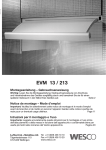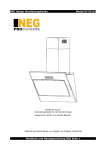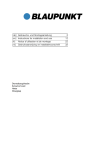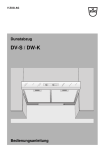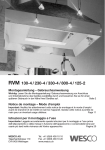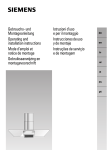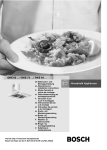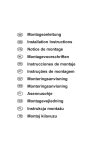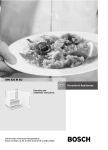Download Bosch DKE 96 . . Operating instructions
Transcript
DKE 66 . . / 76 . . / 96 . . Operating and installation instructions Internet: http://www.bosch-hausgeraete.de Bosch Info-Team: de Tel. 01 80/5 30 40 50 (E 0,12/Min. DTAG) a Fig. 1 GAZ Abb. 1 ELECTRO mind. 650 2 mind. 550 Gebrauchsanweisung: Gerätebeschreibung Betriebsarten Kaminverblendung Schalter Licht / Lüfter Filtergitter Beleuchtung Betriebsarten Dies kann erreicht werden, wenn durch nicht verschließbare Öffnungen, z. B. in Türen, Fenstern und in Verbindung mit Zuluft-/Abluftmauerkasten oder durch andere techn. Maßnahmen, wie gegenseitige Verriegelung o. ä., die Verbrennungsluft nachströmen kann. Bei nicht ausreichender Zuluft besteht Vergiftungsgefahr durch zurückgesaugte Verbrennungsgase. Ein Zuluft-/Abluftmauerkasten allein stellt die Einhaltung des Grenzwertes nicht sicher. Anmerkung: Bei der Beurteilung muss immer der gesamte Lüftungsverbund der Wohnung beachtet werden. Bei Betrieb von Kochgeräten, z. B. Kochmulde und Gasherd wird diese Regel nicht angewendet. Wenn die Dunstabzugshaube im Umluftbetrieb – mit Aktivkohlefilter – verwendet wird, ist der Betrieb ohne Einschränkung möglich. Abluftbetrieb: Umluftbetrieb: ❑ Der Lüfter der Dunstabzugshaube saugt den Küchendunst an und leitet ihn durch den Fettfilter ins Freie. ❑ Der Fettfilter nimmt die fettigen Bestandteile des Küchendunstes auf. ❑ Die Küche bleibt weitgehend frei von Fett und Geruch. D Bei Abluftbetrieb der Dunstabzugshaube und gleichzeitigem Betrieb schornsteinabhängiger Feuerungen (wie z. B. Gas-, Öl- oder Kohleheizgeräte, Durchlauferhitzer, Warmwasserbereiter) muss für ausreichend Zuluft gesorgt werden, die von der Feuerstätte zur Verbrennung benötigt wird. Ein gefahrloser Betrieb ist möglich, wenn der Unterdruck im Aufstellraum der Feuerstätte von 4 Pa (0,04 mbar) nicht überschritten wird. ❑ Hierzu muss ein Aktivkohlefilter eingebaut werden (siehe Filter und Wartung). Das komplette Montage-Set sowie die Ersatzfilter können Sie beim Fachhandel erwerben. Die entsprechenden Zubehör-Nummern finden Sie am Ende dieser Gebrauchsanweisung. ❑ Der Lüfter der Dunstabzugshaube saugt den Küchendunst an und leitet ihn durch den Fett- und Aktivkohlefilter gereinigt in die Küche zurück. ❑ Der Fettfilter nimmt die fettigen Bestandteile des Küchendunstes auf. ❑ Der Aktivkohlefilter bindet die Geruchsstoffe. Wird kein Aktivkohlefilter eingebaut, können keine Geruchsstoffe des Küchendunstes gebunden werden. 3 Before using for the first time Important notes: ❑ The Instructions for Use apply to several versions of this appliance. Accordingly, you may find descriptions of individual features that do not apply to your specific appliance. ❑ This extractor hood complies with all relevant safety regulations. Repairs should be carried out by qualified technicians only. Improper repairs may put the user at considerable risk. Do not use the appliance if damaged. The appliance may be connected to the mains by a qualified technician only. The appliance is not intended for use by young children or infirmed persons without supervision. Young children should be supervised to ensure they do not play with the appliance. If the connecting cable for this ❑ Before using your appliance for the first time, please read these Instructions for Use carefully. They contain important information concerning your personal safety as well as on use and care of the appliance. ❑ Please retain the operating and installation instructions for a subsequent owner. The hotplates must always be covered with a utensil. Restrictions apply to the use of the extractor hood over a solid-fuel burner (coal, wood, etc.). (See Installation instructions). Gas hobs / Gas cookers Do not use all the gas hotplates simultaneously for a prolonged period (max. 15 minutes) at maximum thermal load, otherwise there is a risk of burns if the housing surfaces are touched or a risk of damage to the extractor hood. If the extractor hood is situated over a gas hob, operate the hood at maximum setting if three or more gas hotplates are operated simultaneously. Light bulbs must always be fitted when the extractor hood is in use. If you encounter a problem Defective bulbs should be replaced immediately to prevent the remaining bulbs from overloading. If you have any questions or if a fault occurs, please call Customer Service. (See list of Customer Service representatives). When you call, please quote the following: appliance is damaged, the cable must be replaced by the manufacturer or his customer service or a similarly qualified person in order to prevent serious injury to the user. Dispose of packaging materials properly (see Installation instructions). This extractor hood is designed for domestic use only. Never operate the extractor hood without a grease filter. Overheated fat or oil can easily catch fire. If you are cooking with fat or oil, e.g. chips, etc., never leave the cooker unattended. Do not flambé food directly under the extractor hood. Risk of grease filter catching fire due to flames. ! 4 E-Nr. FD Enter the relevant numbers into the box above. The E-Nr. (product no.) and FD (production date) are shown on the nameplate which can be seen inside the extractor hood after the filter frame has been detached. Operating procedure The most effective method of removing vapours produced during cooking is to: ❑ Switch the ventilator ON as soon as you begin cooking. ❑ Switch the ventilator OFF a few minutes after you have finished cooking. Light ON / OFF Fan OFF Lighting: ❑ The light can be switched on at any time, even though the fan is switched off. Filters and maintenance Grease filters: 0 Reduce fan speed Metal filters are used to trap the greasy element of the vapours that develop during cooking. The filter mats are made from noncombustible metal. Fan ON and increase speed Intensive setting Display for fan setting Switching the fan ON ❑ Press the + button. Setting the required fan speed: ❑ Press the + button. The fan speed is increased by one step. ❑ Press the – button. The fan speed is reduced by one step. Switching the fan OFF: ❑ Press the 0 button. Or: ❑ Keep pressing the – button until the fan switches off. Intensive setting: Maximum power is obtained at the intensive setting. It is only required for short intervals. ❑ Keep pressing the + button until a ç appears in the display. ❑ If the intensive setting is not cancelled by hand, the fan will automatically switch back to step } after 10 minutes. Caution: As the filter becomes more and more saturated with grease, not only does the risk of it catching fire increase but the efficiency of the extractor hood can also be adversely affected. Important: By cleaning the metal grease filters at appropriate intervals, the possibility of them catching fire as a result of a build-up of heat such as occurs when deep-fat frying or roasting is taking place, is reduced. Cleaning the metal grease filters: ❑ In normal operation (1 to 2 hours daily), the metal grease filter must be cleaned after 8 to 10 weeks. ❑ The filters can be cleaned in a dishwasher. It is however possible that they will become slightly discoloured. ❑ The filter must be placed loosely, and NOT wedged, in the dishwasher. Important: Metal filters that are saturated with grease should not be washed together with other dishes etc. ❑ When cleaning the filters by hand, soak them in hot soapy water first of all. Then brush the filters clean, rinse them thoroughly and leave the water to drain off. 5 Filters and maintenance Removing and inserting the metal grease filters: Warning: The halogen bulbs must be switched off and cool. 1. Press the catch on the grease filters inwards and fold the filters down. 3. Engage the lug at the front. 4. Insert the metal grease filters (see "Removing and inserting the metal grease filters"). Removing the filter: Warning: The halogen bulbs must be switched off and cool. 1. Remove the metal filters. 2. Press in the lug at the front and remove the activated carbon filter. 2. Clean the filters. 3. Insert the clean filters back into the hood. Activated carbon filter: For neutralizing odours in recirculating mode. Warning: The halogen bulbs must be switched off and cool. Inserting the filter: 1. Remove the metal filters (see "Removing and inserting the metal grease filters"). 2. Insert the activated carbon filter. 6 3. Insert the metal grease filters. Replacing the activated carbon filter: ❑ During normal operation (1 to 2 hours per day) the activated carbon filters should be replaced approximately 1 x year. ❑ A replacement filter can be obtained from any authorized dealer (see optional accessories). ❑ Use original filters only. By doing so you will obtain maximum performance from your extractor hood. Disposing of the old activated carbon filter: ❑ There are no pollutants in the activated carbon filters. They can therefore be disposed of as part of your normal domestic refuse. Cleaning and care Replacing the light bulbs Disconnect the extractor hood from the electricity supply by pulling out the mains plug or switching it off at the fuse box. ❑ At the same time as you clean the grease filters, clean off any grease from all accessible parts of the housing. This significantly reduces the fire hazard and ensures that the extractor hood performs as effectively as possible. ❑ Use a hot detergent solution or a mild window cleaner to clean the canopy of the extractor hood. ❑ Do not scrape off any dirt that has dried on but loosen it up with a damp cloth. ❑ Do not use abrasive cleaning agents or sponges that could cause scratches. ❑ Note: Do not use alcohol (spirit) on plastic parts, otherwise the surface may become matt in appearance. Caution: Ensure that the kitchen is adequately ventilated. Avoid naked flames! 1. Switch off the extractor hood and pull out the mains plug or switch off the electricity supply at the fuse box. Clean the operating buttons with a mild soapy solution and a soft, damp cloth only. Do not use stainless-steel cleaner to clean the operating buttons. When switched on, the halogen bulbs become very hot. Even for some time after the bulbs have been switched off there is still a risk of burns. 2. Remove the bulb ring with a screwdriver or similar tool. 3. Replace the halogen light bulb (conventional halogen bulb, 12 Volt, max. 20 Watt, G4 cap). Caution: Refer for plug-in lampholder. Take hold of the bulb with a clean cloth. Stainless steel surfaces: ❑ Use a mild non-abrasive stainless steel cleaner. ❑ Clean the surface in the same direction as it has been ground and polished. Do not use any of the following to clean stainless steel surfaces: abrasive sponges, cleaning agents containing sand, soda, acid or chloride! 4. Re-insert the bulb ring. 5. Plug the appliance into the mains or switch it on at the fuse box. Note: If the light does not function, check that the bulbs have been inserted correctly. Aluminium and plastic surfaces: ❑ Use a soft, non-linting window cloth or micro-fibre cloth. ❑ Do not use dry cloths. ❑ Use a mild window cleaning agent. ❑ Do not use aggressive, acidic or caustic cleaners. ❑ Do not use abrasive agents. 7 Installation Instructions: Important information Old appliances are not worthless rubbish. Valuable raw materials can be reclaimed by recycling old appliances. Before disposing of your old appliance, render it unusable. You received your new appliance in a protective shipping carton. All packaging materials are environmentally friendly and recyclable. Please contribute to a better environment by disposing of packaging materials in an environmentally-friendly manner. Please ask your dealer or inquire at your local authority about current means of disposal. The extractor hood can be used in exhaust air or circulating air mode. Always mount the extractor hood over the centre of the hob. Minimum distance between electric hob and bottom edge of extractor hood: 550 mm, Fig. 1. The extractor hood must not be installed over a solid fuel cooker – a potential fire hazard (e.g. flying sparks) – unless the cooker features a closed, non-removable cover and all national regulations are observed. The smaller the gap between the extractor hood and hotplates, the greater the likelihood that droplets will form on the underside of the extractor hood. 8 Additional information concerning gas cookers: When installing gas hotplates, comply with the relevant national statutory regulations (e.g. in Germany: Technische Regeln Gasinstallation TRGI). Always comply with the currently valid regulations and installation instructions supplied by the gas appliance manufacturer. Only one side of the extractor hood may be installed next to a high-sided unit or high wall. Gap at least 50 mm. Minimum distance on gas hotplates between the upper edge of the trivet and lower edge of the extractor hood: 650 mm, Fig. 1. Prior to installation Exhaust-air mode mind.38 550 120 150 120 150 715-1100 mind .128 630 260 280 520 The exhaust air is discharged upwards through a ventilation shaft or directly through the outside wall into the open. D Exhaust air should neither be directed into a smoke or exhaust flue that is currently used for other purposes, nor into a shaft that is used for ventilating rooms in which stoves or fireplaces are also located. Exhaust air may be discharged in accordance with official and statutory regulations only (e.g. national building regulations). Local authority regulations must be observed when discharging air into smoke or exhaust flues that are not otherwise in use. D When the extractor hood is operated in exhaust-air mode simultaneously with a different burner which also makes use of the same chimney (such as gas, oil or coal-fired heaters, continuous-flow heaters, hot-water boilers) care must be taken to ensure that there is an adequate supply of fresh air which will be needed by the burner for combustion. Safe operation is possible provided that the underpressure in the room where the burner is installed does not exceed 4 Pa (0.04 mbar). mind. 600 48 00 0/9 /70 600 This can be achieved if combustion air can flow through non-lockable openings, e.g. in doors, windows and via the airintake/exhaust-air wall box or by other technical measures, such as reciprocal interlocking, etc. If the air intake is inadequate, there is a risk of poisoning from combustion gases which are drawn back into the room. An air-intake/exhaust-air wall box by itself is no guarantee that the limiting value will not be exceeded. Note: When assessing the overall requirement, the combined ventilation system for the entire household must be taken into consideration. This rule does not apply to the use of cooking appliances, such as hobs and ovens. Unrestricted operation is possible if the extractor hood is used in recirculating mode – with activated carbon filter. If the exhaust air is going to be discharged into the open, a telescopic wall box should be fitted into the outside wall. 9 Prior to installation For optimum extractor hood efficiency: ❑ Short, smooth air exhaust pipe. ❑ As few bends in the pipe as possible. ❑ Diameter of pipe to be as large as possible and no tight bends in pipe. If long, rough exhaust-air pipes, many pipe bends or smaller pipe diameters are used, the air extraction rate will no longer be at an optimum level and there will be an increase in noise. ❑ Round pipes: We recommend Internal diameter: 150 mm (at least 120 mm). ❑ Flat ducts must have an internal crosssection that equates to that of round pipes. There should be no sharp bends. l 120 mm approx. 113 cm2 l 150 mm approx. 177 cm2 ❑ If pipes have different diameters: Insert sealing strip. ❑ For exhaust-air mode, ensure that there is an adequate supply of fresh air. Circulating-air mode Connecting a l 150 mm exhaust-air pipe: ❑ Mount the pipe directly onto the air outlet on the hood. Connecting a l 120 mm exhaust-air pipe: ❑ Attach the reducing connector directly to the air pipe. ❑ Attach the exhaust-air pipe to the reducing connector. ❑ With activated carbon filter if exhaust-air mode is not possible. The complete installation set can be obtained from specialist outlets. The corresponding accessory numbers can be found at the end of these operating instructions. mind. 130 550 808-1190 mind .38 630 280 260 520 10 48 600 /70 0/9 00 Prior to installation Electrical connection Preparing the wall Electrical data: ❑ The wall must be flat and perpendicular. ❑ Ensure that the wall is capable of providing a firm hold for mounting screws and plugs. Are to be found on the name plate inside the appliance after removal of the filter frame. Weight in kg: Exhaust air Recirculating air 60 cm 22,0 27,4 70 cm 23,0 28,4 90 cm 25,1 30,5 We reserve the right to construction changes within the context of technical development. Electrical connection WARNING: THIS APPLIANCE MUST BE EARTHED IMPORTANT: Fitting a Different Plug: The wires in the mains lead are coloured in accordance with the following code: Green and Yellow – Earth Blue – Neutral Brown – Live If you fit your own plug, the colours of these wires may not correspond with the identifying marks on the plug terminals. This is what you have to do: 1. Connect the green and yellow (Earth) wire to the terminal in the plug marked ‘E’ or with the symbol ( ), or coloured green or green and yellow. 2. Connect the blue (Neutral) wire to the terminal in the plug marked ‘N’ or coloured black. 3. Connect the brown (Live) wire to the terminal marked ‘L’, or coloured red. The extractor hood should only be connected to an earthed socket that has been installed according to relevant regulations. If possible, site the earthed socket directly behind the chimney panelling. Before undertaking any repairs, always disconnect the extractor hood from the electricity supply. Length of the connecting cable: 1.30 m. If it is necessary to wire the extractor hood directly into the mains: The extractor hood should only be connected to the electricity supply by a properly qualified electrician. A separator must be installed in the household circuit. A suitable separator is a switch that has a contact gap of more than 3 mm and interrupts all poles. Such devices include circuit breakers and contactors. If the connecting cable for this appliance is damaged, the cable must be replaced by the manufacturer or his customer service or a similarly qualified person in order to prevent serious injury to the user. This extractor hood corresponds to EC regulations concerning RF interference suppression. 11 Installation This extractor hood is intended to be mounted onto the kitchen wall. 1. Remove the grease filter (refer to Operating Instructions). 2. Draw a line on the wall from the ceiling to the lower edge of the hood at the centre of the location where the hood is going to be mounted. 3. Use the template to mark the points on the wall where the screws will be mounted. In order to make it easier to hook the hood onto the screws, draw the outline of the area where the hood will be attached. Ensure that the minimum distance between the hob and the extractor hood is maintained – 550 mm for an electric hob and 650 mm for a gas hob. The bottom edge of the template equates to the lower edge of the extractor hood. 4. Drill 4 x l 8 mm holes for the extractor hood and 2 x l 8 mm holes for the chimney panelling. Insert plugs into the holes so that they are flush with the wall. Note: Take into account any special accessories that are going to be fitted. 5. Attach the 2 enclosed spacers to the fixing bracket for the flue duct panelling. 6. Screw on the upper and the two lower fixing brackets. 23 216 7. Attach the extractor hood. Adjust the height and align horizontally with the adjusting screws. 172 455 68 150 mind.550 Elektro mind.650 Gas The glass screen must not touch the wall. 12 Installation 07. Screw in lower screws (hex screws). If any pressure is exerted on the glass screen when tightening the screws it could lead to glass breakage. 08. Stick protective film over the holes of the 2 lower mounting bolts in the protective grid. 13. Insert the complete flue duct at an angle into the glass shield and swivel backwards. Warning: The holes in the flue duct must be positioned exactly over the switches. 3. 1. 2. 2. 1. 14. Carefully pull the upper flue duct upwards and screw the sides to the fixing bracket with 2 screws. 09. Connect up the air outlet pipe. 10. Connect the hood to the electricity supply. 11. Remove the protective film from the two flue ducts. Take care not to damage the stainless steel surfaces which are susceptible to scratches etc. 12. Insert the upper flue duct (slots downwards) into the lower flue duct. Protect the cover panels from scratches, for example by laying the template used for marking the wall over the top edge of the lower section. 15. Insert the grease filter (refer to Operating Instructions). 13 Notes 14 1 2x 2 10x 3 DHZ 5185 4 5 2x 6 360732 15 Robert Bosch Hausgeräte GmbH 5750 207 133 Printed in Germany 0904 Es.
















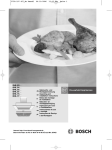
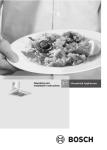
![[de] Gebrauchs- und Montageanleitung 2 [en] Instructions](http://vs1.manualzilla.com/store/data/006783472_1-9623bc8bb4187c1cd6f5b4be12ce6579-150x150.png)
